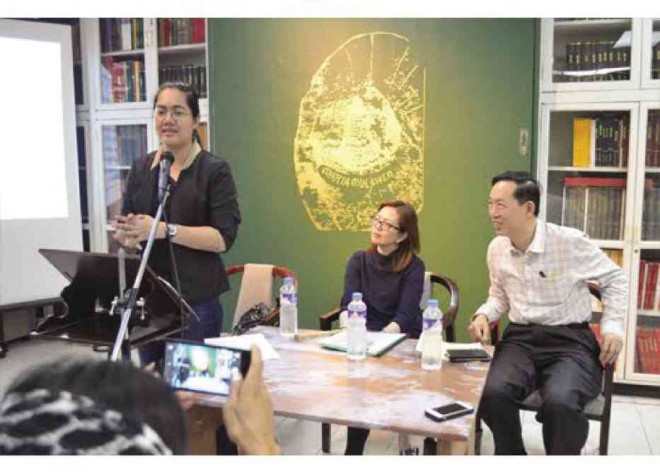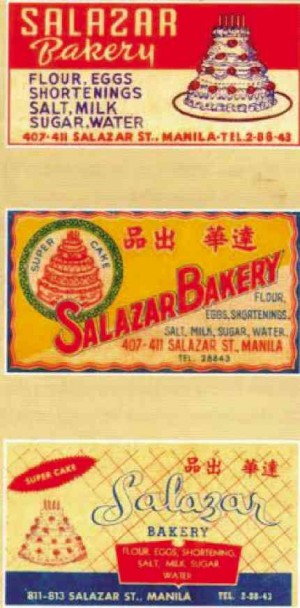
There was much laughter that afternoon although the discussion was about being a serious food writer and researcher. The mood was light, maybe because the invited guests knew each other, or perhaps due to the nature of the experiences related by writers Amy Uy and Jenny Orillos, in the course of researching for their book, “Panaderia,” and the humorous anecdotes of Wilson Flores of Kamuning Bakery.
The talk was held at Lopez Museum and Library, which also houses much of the information on the history of bread-making in the country. It was food historian Felice Sta. Maria, writer of the introduction to “Panaderia,” who first pointed the authors to the museum for their research.
Uy talked of materials she obtained from book collections including the 55-volume “The Philippine Islands” by Emma Blair and James Alexander Robertson.
But what contained more interesting information were bread labels and advertisements in newspapers from Sta. Maria’s own collection donated to the museum.
The labels give the name of the bakery, its address, products and ingredients. Salazar Bakery on Salazar Street in Binondo, Manila, offered Super Cake made of flour, eggs, shortening, salt, milk, sugar, water. Panaderia Villegas in Malolos, Bulacan, indicated its specialties—enseimada, biscocho, principe and aru-ru, which must have been another spelling for araru or uraro, cookies made with arrowroot flour.
Advertisements give an idea of the products available at the time and the companies that made them. For instance, Ma. Luisa’s Bakery in Cubao offered to do orders (pedido) for Christmas of cookies like camachile, galletas, mamon tostado and enseymadas. (Notice the different spelling of ensaymada in the two previous examples.)
‘Festive bread’
Orillos focused her talk on the particular “festive bread,” as the book described it: “If pan de sal is our daily bread, ensaymada is the bread we indulge in.”
Ensaymada, as Filipinos know it, is coiled bread that can be simply sugared bread or a calorie-laden would-be pastry with ample amounts of butter, cheese and sugar. Orillos said that Uy went to Spain for research and found the ensaimada at Pasteleria Escriba in Barcelona disappointing because it lacked the fluff and richness of the Pinoy versions.
In Pampanga, the authors spent half their time tracking down different ensaymada makers, going to Corazon’s Sweets and Pastries in Magalang and to Lillian Boromeo in Mexico, then later interviewing in Manila the Medinas of Arayat, the family of Imang Salud of San Fernando, the Hizons of Bacolor and Mexico.
An advertisement by El Gusto Panaderia y Reposteria in Azcarraga (now Claro M. Recto), Manila, for Felices Pascua (Christmas) proudly announced, “Ensaimadas de la Pampanga.” Orillos said it just goes to show how Pampanga ensaimada was already famous even then.
Bulacan’s version is still faithfully done today by Eurobake, originally known as La Panaderia Concepcion.
In the book, Bulacan historian Dez Bautista was tapped for what he remembers of Villegas Bakery in Malolos where the special ensaymada had ham and salted egg on top. Orillos regaled the audience with Bautista’s story of how bakery owner Ka Puring would make the batter in a locked room at dawn.
Orillos also related how I had written in 1986 that the secret of that particular ensaymada was in a tin can that Ka Puring herself showed me, supposedly the levadura, the leaven or yeast.
Later, thinking that her secret was safe with Bautista who was actually her relative, Ka Puring revealed that it was kneaded potatoes. In the recipe section of the book, Jill Sandique included a potato ensaymada.

The event also featured a tasting of panaderia breads including the ensaymada made by a culinary arts student, who wanted Orillos to see if it was properly done. Next was a sampling of panaderia ensaymada and other breads, like the pinagong courtesy of Kamuning Bakery.
Flores briefly recounted how he acquired Kamuning Bakery from its original owners, and the changes he had made such as opening a café, adjacent to the bakery, where he holds his weekly Pandesal Forum on national issues.
He assured the audience that the bakery still uses the wood-burning pugon (oven). He was aware that sourcing wood for the pugon had been a problem that was solved by networking on the Internet. After posting online that he needed firewood, many homeowners responded, grateful that somebody can use scrap branches from their trees that needed pruning.
And that’s not counting trees uprooted by typhoons. Flores’ only problem now is where to store so much wood.
The talk ended hilariously when Flores said he used “artistic license” to tell a story for young children who toured his bakery. Explaining the origin of the name Kamuning, instead of telling the kids that there used to be a lot of kamuning trees in the area before housing projects took over (and he promised to restore those trees), Flores said the first bakers there were a man named Kamun and a woman named Ning.















































